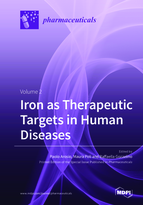Iron as Therapeutic Targets in Human Diseases
A special issue of Pharmaceuticals (ISSN 1424-8247).
Deadline for manuscript submissions: closed (15 July 2019) | Viewed by 398121
Special Issue Editors
Interests: iron metabolism; ferritin; iron storage
Special Issues, Collections and Topics in MDPI journals
Interests: iron metabolism; hepcidin regulation; heparin; ferroptosis; tumor
Special Issues, Collections and Topics in MDPI journals
Interests: gut microbiota; gut microbiome; iron metabolism; heme biology; inflammation; infections and neurodegeneration
Special Issues, Collections and Topics in MDPI journals
Special Issue Information
Dear Colleagues,
Iron is an essential element for almost all organisms, a cofactor playing a crucial role in a number of vital functions, including oxygen transport, DNA synthesis and respiration. However, its ability to exchange electrons renders excess iron potentially toxic, since capable to catalyze the formation of highly poisonous free radicals. As a consequence, iron homeostasis is tightly controlled by sophisticated mechanisms that have been partially elucidated. Because of its biological importance, numerous disorders have been recently linked to deregulation of iron homeostasis, which include not only the typical disorders of iron overload and deficiency, but also cancer and neurodegenerative diseases. This leads iron metabolism to become an interesting therapeutic target for novel pharmacological treatments against these diseases. Several therapies are currently under development for hematological disorders, while other are being considered for different pathologies. The therapeutic targeting under study includes the hepcidin/ferroportin axis for the regulation of systemic iron homeostasis, the complex cytosolic machineries for the regulation of intracellular iron status and its association with oxidative damage and reagents exploiting proteins of iron metabolism such as ferritin and transferrin receptor. A promising potential target is a recently described form of programmed cell death named ferroptosis, in which the role of iron is essential but not completely clarified. This Special Issue has the aim to summarize the state-of-the-art, and the latest findings published in the iron field, as well as to elucidate future directions.
Prof. Dr. Paolo Arosio
Dr. Maura Poli
Dr. Raffaella Gozzelino
Guest Editors
Manuscript Submission Information
Manuscripts should be submitted online at www.mdpi.com by registering and logging in to this website. Once you are registered, click here to go to the submission form. Manuscripts can be submitted until the deadline. All submissions that pass pre-check are peer-reviewed. Accepted papers will be published continuously in the journal (as soon as accepted) and will be listed together on the special issue website. Research articles, review articles as well as short communications are invited. For planned papers, a title and short abstract (about 100 words) can be sent to the Editorial Office for announcement on this website.
Submitted manuscripts should not have been published previously, nor be under consideration for publication elsewhere (except conference proceedings papers). All manuscripts are thoroughly refereed through a single-blind peer-review process. A guide for authors and other relevant information for submission of manuscripts is available on the Instructions for Authors page. Pharmaceuticals is an international peer-reviewed open access monthly journal published by MDPI.
Please visit the Instructions for Authors page before submitting a manuscript. The Article Processing Charge (APC) for publication in this open access journal is 2900 CHF (Swiss Francs). Submitted papers should be well formatted and use good English. Authors may use MDPI's English editing service prior to publication or during author revisions.
Keywords
- iron homeostasis
- ferritin
- ferritinophagy
- hepcidin
- ferroptosis
- iron chelators
- neurodegeneration
- inflammation
- cancer
Related Special Issue
- Iron as Therapeutic Targets in Human Diseases 2020 in Pharmaceuticals (3 articles)









